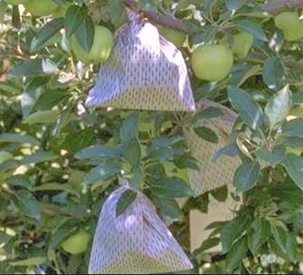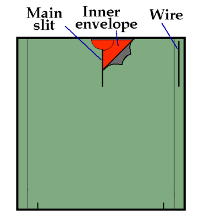Bagging Apples: Alternative Pest Management for Hobbyists
ENTFACT-218: Bagging Apples | Download PDF
by Ric Bessin and John Hartman, Extension Specialists
University of Kentucky College of Agriculture
Homeowners plant apple trees for a variety of reasons: for the benefit of fresh fruit, for control over what pesticides are applied, or perhaps for nostalgic reasons. But producing quality apples in the backyard can be very challenging. Attempts at apple growing are frequently met with disappointment because trees and pests are poorly managed. Growers are frequently unaware of potential pest problems and management options.

Figure 1. Bagging helps with pest management and improves fruit finish.
Common apple pests and diseases such as fire blight, apple scab, plum curculio, codling moth, San Jose scale, and rosy apple aphid can severely damage trees and/or fruit. Other pests and diseases such as stink bugs, flyspeck, and sooty blotch reduce the aesthetic and keeping quality of the fruit. Knowing that pests are likely to appear, some gardeners may use excessive amounts of fruit spray mixtures and may be left wondering whether or not their apples are safe. While impractical for commercial growers, bagging of fruit on the tree provides an effective alternative to pesticide sprays throughout most of the season.
Fruit bagging has been used in commercial orchards on the west coast to improve fruit finish on apples for export to Asian countries. But the bags also act as a barrier to protect the fruit against attack by summer insect pests and diseases.
Individual fruits are bagged in the spring when they reach 3/4" in diameter and remain bagged until 3 weeks before harvest. No additional pesticide sprays are needed once the bags are placed on the fruit. When the bags are used on disease resistant cultivars (See ID-21, Disease and Insect Control Program for Home Grown Fruit in Kentucky), all but the two insecticide sprays used just after bloom can be eliminated. The steps involved with fruit bagging include:
- early season pest management,
- thinning of the fruit,
- placing bags on the fruit, and
- bag removal.
Early Season Pest Management
Apple scab, cedar apple rust and fire blight are early season diseases that attack the trees prior to apple bagging. Home gardeners should either use disease resistant varieties or follow Extension service recommendations for controlling these diseases before bagging. Selection of the proper disease resistant variety and the use of good cultural practices may eliminate the need for early season fungicide sprays.
All trees should be pruned normally and receive a thorough dormant oil spray during the late winter or early spring. Plum curculio attacks the apples before the fruit are large enough to bag. Additionally, codling moth can lay eggs on the fruit prior to bagging. So before bagging, gardeners should apply an insecticide, such as Imidan, for control of plum curculio and codling moth at the petal fall stage and again two weeks later. Petal fall is when all of the petals have fallen off of the blossoms. Organic growers may select Rotenone to control plum curculio. These would be the last pesticide applications of the year.
Thinning
When the fruit are about 1/2 to 3/4 of an inch in diameter, the fruit should be thinned to a single fruit per fruit cluster with approximately one fruit per six to seven inches of limb. This will help to produce large fruit and encourage return bloom next year. The fruit can be thinned at the same time that the apples are bagged.
Bagging
When the apples reach 1/2 to 3/4 of an inch in diameter, they are ready to be bagged. This should be about three weeks after petal fall. There are two different ways to bag apples. One method is to use bags from Japan that are designed for fruit bagging, the other method uses locally obtained bags and twist ties. The two-layer Japanese apple bags are more durable and produce apples that are higher in quality than the local bags, but they are more difficult to find.
The Japanese apple bag has a long slit near the opening of the bag and a wire embedded along one edge. The bag is placed over the fruit with the stem of the developing apple slipped into the slit. The opening of the bag is gathered in a pleat-like manner and the A typical Japanese apple bag wire running along the edge of the bag is crimped over the pleated opening to secure the bag. The bag is now fastened to the apple and should remain in place for the season. Some practice is needed to learn this skill.
Bags obtained from the local hardware or discount store can be used in place of the Japanese bags. A 3-pound paper bag that has been cut to about 6 inches in length is equivalent to the size of the Japanese bags. The bag is placed over the developing apple by slipping the slit of the bag over the stem of the apple. The opening of the bag is pleated shut and a short piece of twist tie is used to secure the bag firmly to the fruit.
Continue to apply bags to the rest of the fruit on the tree. Once the fruit have been bagged, no additional pesticide sprays should be needed for the rest of the season.

Figure 2. Typical Japanese-style fruit bag
Bag Removal
If the bags are left on the fruit until harvest, the fruit will not color properly. Even red apple varieties will be light yellow in color when ripe. So the bags need to be removed three weeks before harvest to allow the fruits to color properly. Generally, during this late summer period, no additional sprays are needed.
The fruit can be harvested at the normal time. You may notice the fine finish on apples produced with the bagging method.
Summary of 1995-1998 Apple Bagging Studies

- Wilson Irrigation & Orchard Supplies 1902 S. 11th St., Union Gap, WA 98903
(800) 232-1174
($0.18 ea.)
Revised: 11/19
CAUTION! Pesticide recommendations in this publication are registered for use in Kentucky, USA ONLY! The use of some products may not be legal in your state or country. Please check with your local county agent or regulatory official before using any pesticide mentioned in this publication.
Of course, ALWAYS READ AND FOLLOW LABEL DIRECTIONS FOR SAFE USE OF ANY PESTICIDE!
Photos courtesy Ric Bessin, University of Kentucky Entomology
